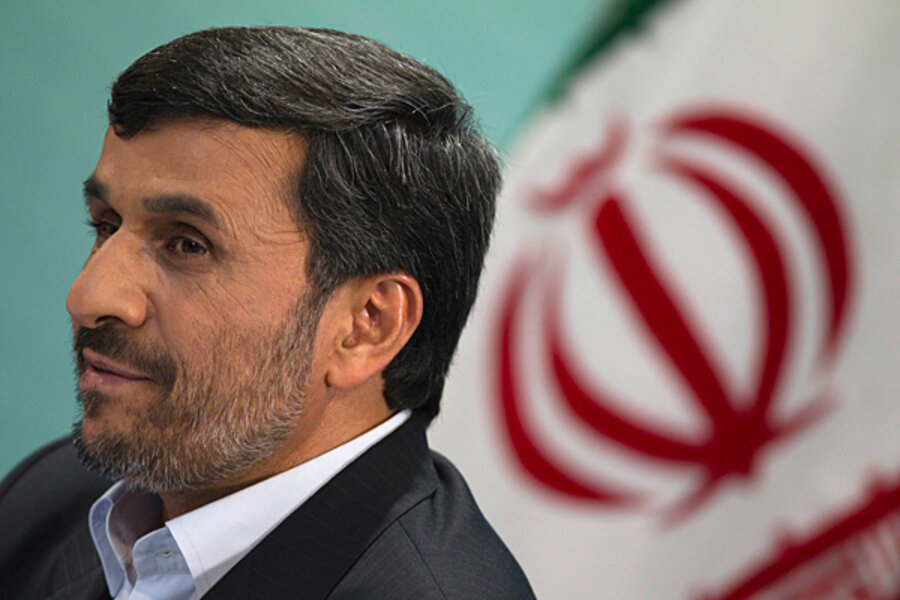Mideast unrest could boost Iran, but it faces upheaval at home
Loading...
| Washington
Tehran has much at stake in the tumult wracking the Middle East, with popular uprisings in the region potentially opening the way for Iran to expand its political influence.
But on the ground in Iran, the country's regional strength has been overshadowed by an ailing economy and the inability of the Iranian Majles, or parliament, to enforce financial transparency in President Mahmoud Ahmadinejad's administration. The most contentious debate has been over the Iranian president's rapid cutbacks in subsidy spending.
Though a majority of parliamentarians supported legislation enforcing large-scale reductions in the country's annual $90 billion to $100 billion in subsidy spending, lawmakers have become wary of the government's accelerated implementation of the cuts and have sought to limit the president's control over their administration.
Though officials have argued since 1992 for cutbacks in subsidy spending, favoring cash payments instead, economists in Iran argue the rapid implementation of the current legislation could boost inflation to levels that will dilute the purchasing power of the payments as energy and food prices start to rise.
$20 billion in subsidies slashed
To date, Mr. Ahmadinejad's government has slashed $20 billion worth of subsidies for fuel – including gasoline, heating oil, kerosene, liquefied petroleum gas (LPG), and fuel oil – as well as for electricity and natural gas. Subsidies for water, flour, bread, wheat, rice, oil, milk, sugar, and postal and transportation services are slated to be phased out by March 2014. Some $5 billion in new subsidy cuts will take place within the next year, according to domestic reports.
Original plans called for the state's annual $35 billion to $45 billion in fuel subsidies, which included gasoline imports worth between $6.5 billion and $8 billion a year, to be phased out incrementally within three years starting in 2009. Gasoline prices were to be raised gradually before settling in 2012 at a partially subsidized value worth 90 percent of the Persian Gulf Free on Board (FOB) gasoline price, which accounts for shipping and loading costs, according to interviews with government officials.
Implementation was delayed by two years, which should have kept prices well under FOB prices until 2013. Yet today, gasoline prices for private individuals are already approaching regional FOB levels. Currently they pay 4,000 rials per liter (about $1.52 a gallon) for their 60-liter quota of regular gasoline and 7,000 rials a liter ($2.70 per gallon) for purchases beyond quota.
“The president had two more years to implement the plan, but he finished it this year,” says a Tehran-based analyst speaking on condition of anonymity. “Parliament was shocked.”
Want to keep up with the Monitor's best stories? Sign up for our daily World Editor's Picks newsletter.
In January, the government started making direct cash payments to registered citizens as a countermeasure against expected price rises in electricity, gasoline and general foodstuffs, such as wheat and bread, resulting from the cuts.
Though initial legislation limited cash handouts to the lower-income half of Iran's population, which forms the core of Ahmadinejad's political base, a parliamentary vote in November imposed changes that forced the Ahmadinejad administration to disburse money to all citizens who have registered to receive them, regardless of income class. More than 68.5 million people, or more than 90 percent of Iran's population, have registered for the subsidy payment, according to Iran's Ministry of Welfare.
The monthly payments were supposed to cost the government only a fraction of what it had been paying in subsidies, though that has become less certain. The payment amount was raised from $41 in January to $43 after the Iranian new year in March, will cost the government around $2.9 billion a month – a figure Iran-based economists say will become unsustainable in light of mounting inflation and a steep decline in oil sales that has decreased Iran's cash reserves.
The government will soon be forced to eliminate specific deciles of recipients, and the first to stop receiving cash payments will be the country's cash-strapped middle class, analysts say. This will have a crucial impact on the living standard of Iran's middle income families, which generally live on tighter budgets, use more electricity, and will be hit hardest when food prices rise on the back of price hikes in energy and transport. It poses critical political implications as well, since Iran's burgeoning middle class has for the last two decades served as the strongest base of support for reform inside the Islamic Republic. Economic hardship could reduce their will to fight for reform.
“There will be eliminations, probably within the next six months. Like any other middle class in the world, ours is leveraged to the hilt, so any change in budget is going to hit them,” says the Iran-based analyst. “The middle class is going to get really crushed.”





